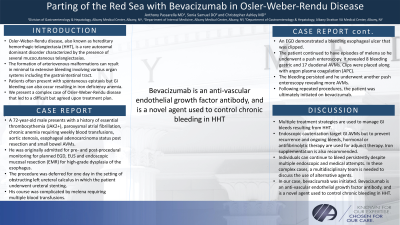Tuesday Poster Session
Category: GI Bleeding
P3467 - Parting of the Red Sea with Bevacizumab in Osler-Weber-Rendu Disease
Tuesday, October 24, 2023
10:30 AM - 4:00 PM PT
Location: Exhibit Hall

Has Audio

Sonia Samuel, DO
Albany Medical Center
Albany, NY
Presenting Author(s)
Anthony Passarella, MD1, Sonia Samuel, DO2, Christopher Ashley, MD3
1Albany Medical College, Albany, NY; 2Albany Medical Center, Albany, NY; 3Albany Stratton VA Medical Center, Albany, NY
Introduction: Osler-Weber-Rendu disease, also known as hereditary hemorrhagic telangiectasia (HHT), is a rare autosomal dominant disorder characterized by the presence of several mucocutaneous telangiectasias. The formation of arteriovenous malformations can result in minimal to extensive bleeding involving various organ systems including the gastrointestinal (GI) tract. Patients often present with spontaneous epistaxis but GI bleeding can also occur resulting in iron deficiency anemia. We present a complex case of Osler-Weber-Rendu disease that led to a difficult but agreed upon treatment plan.
Case Description/Methods: A 72-year-old male presents with a history of essential thrombocythemia (JAK2+), paroxysmal atrial fibrillation, chronic anemia requiring weekly blood transfusions, aortic stenosis, esophageal adenocarcinoma status post resection and small bowel arteriovenous malformations (AVMs). He was originally admitted for pre- and post-procedural monitoring for planned esophagogastroduodenoscopy (EGD), endoscopic ultrasound (EUS) and endoscopic muscoal resection (EMR) for high-grade dysplasia of the esophagus. The procedure was deferred for one day in the setting of obstructing left ureteral calculus in which the patient underwent ureteral stenting. His course was complicated by melena requiring multiple blood transfusions. An EGD demonstrated a bleeding esophageal ulcer that was clipped. The patient continued to have episodes of melena so he underwent a push enteroscopy. It revealed 8 bleeding gastric and 17 duodenal AVMs. Clips were placed along with argon plasma coagulation (APC). The bleeding persisted and he underwent another push enteroscopy revealing more AVMs. Following repeated procedures, the patient was ultimately initiated on bevacizumab.
Discussion: Multiple treatment strategies are used to manage GI bleeds resulting from HHT. Endoscopic cauterization target GI AVMs but to prevent recurrence and ongoing bleeds, hormonal or anti-fibrinolytic therapy are used for adjunct therapy. Iron supplementation is also recommended. Individuals can continue to bleed persistently despite multiple endoscopic and medical attempts. In these complex cases, a multidisciplinary team is needed to discuss the use of alternative agents. In our case, bevacizumab was initiated. Bevacizumab is an anti-vascular endothelial growth factor antibody and is a novel agent used to control chronic bleeding in HHT.
Disclosures:
Anthony Passarella, MD1, Sonia Samuel, DO2, Christopher Ashley, MD3. P3467 - Parting of the Red Sea with Bevacizumab in Osler-Weber-Rendu Disease, ACG 2023 Annual Scientific Meeting Abstracts. Vancouver, BC, Canada: American College of Gastroenterology.
1Albany Medical College, Albany, NY; 2Albany Medical Center, Albany, NY; 3Albany Stratton VA Medical Center, Albany, NY
Introduction: Osler-Weber-Rendu disease, also known as hereditary hemorrhagic telangiectasia (HHT), is a rare autosomal dominant disorder characterized by the presence of several mucocutaneous telangiectasias. The formation of arteriovenous malformations can result in minimal to extensive bleeding involving various organ systems including the gastrointestinal (GI) tract. Patients often present with spontaneous epistaxis but GI bleeding can also occur resulting in iron deficiency anemia. We present a complex case of Osler-Weber-Rendu disease that led to a difficult but agreed upon treatment plan.
Case Description/Methods: A 72-year-old male presents with a history of essential thrombocythemia (JAK2+), paroxysmal atrial fibrillation, chronic anemia requiring weekly blood transfusions, aortic stenosis, esophageal adenocarcinoma status post resection and small bowel arteriovenous malformations (AVMs). He was originally admitted for pre- and post-procedural monitoring for planned esophagogastroduodenoscopy (EGD), endoscopic ultrasound (EUS) and endoscopic muscoal resection (EMR) for high-grade dysplasia of the esophagus. The procedure was deferred for one day in the setting of obstructing left ureteral calculus in which the patient underwent ureteral stenting. His course was complicated by melena requiring multiple blood transfusions. An EGD demonstrated a bleeding esophageal ulcer that was clipped. The patient continued to have episodes of melena so he underwent a push enteroscopy. It revealed 8 bleeding gastric and 17 duodenal AVMs. Clips were placed along with argon plasma coagulation (APC). The bleeding persisted and he underwent another push enteroscopy revealing more AVMs. Following repeated procedures, the patient was ultimately initiated on bevacizumab.
Discussion: Multiple treatment strategies are used to manage GI bleeds resulting from HHT. Endoscopic cauterization target GI AVMs but to prevent recurrence and ongoing bleeds, hormonal or anti-fibrinolytic therapy are used for adjunct therapy. Iron supplementation is also recommended. Individuals can continue to bleed persistently despite multiple endoscopic and medical attempts. In these complex cases, a multidisciplinary team is needed to discuss the use of alternative agents. In our case, bevacizumab was initiated. Bevacizumab is an anti-vascular endothelial growth factor antibody and is a novel agent used to control chronic bleeding in HHT.
Disclosures:
Anthony Passarella indicated no relevant financial relationships.
Sonia Samuel indicated no relevant financial relationships.
Christopher Ashley indicated no relevant financial relationships.
Anthony Passarella, MD1, Sonia Samuel, DO2, Christopher Ashley, MD3. P3467 - Parting of the Red Sea with Bevacizumab in Osler-Weber-Rendu Disease, ACG 2023 Annual Scientific Meeting Abstracts. Vancouver, BC, Canada: American College of Gastroenterology.
